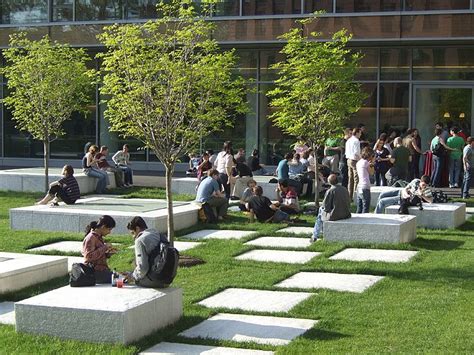Are you passionate about transforming public spaces and creating sustainable designs that benefit communities? If so, pursuing a degree in landscape architecture may be the perfect fit for you. In this blog post, we will explore the top landscape architecture programs offered at universities in the United States. From the importance of transforming public spaces to the curriculum and course offerings, as well as faculty expertise and research opportunities, this post will provide a comprehensive overview of what these programs have to offer. Additionally, we’ll delve into the hands-on learning experiences through design studios, internship and career placement opportunities, and collaborative projects with local communities. We will also highlight the emphasis on sustainable design principles and share success stories of alumni who have made a significant impact in the field. Whether you’re considering a career in landscape architecture or are simply interested in learning more about it, this blog post will provide valuable insights into this rewarding field.
Table of Contents
Introduction to Landscape Architecture Programs
Landscape architecture programs provide students with the necessary skills and knowledge to design and create outdoor spaces that are both functional and aesthetically pleasing. These programs focus on concepts such as sustainability, urban planning, and environmental conservation, preparing students to address the challenges of the built environment.
Students enrolled in landscape architecture programs gain a comprehensive understanding of various design principles and techniques, including site planning, plant materials, and construction methods. They also learn about the historical and cultural influences that shape outdoor spaces, as well as the impact of climate change on landscape design.
Furthermore, landscape architecture programs often emphasize hands-on learning, offering students opportunities to work on real-world projects and collaborate with local communities. Through internships and research opportunities, students can apply their skills in practical settings while developing a deep appreciation for the natural environment.
In summary, landscape architecture programs provide a holistic approach to designing and planning outdoor spaces, equipping students with the expertise and creativity to address the complex challenges of modern urban landscapes.
The Importance of Transforming Public Spaces
Transforming public spaces is crucial for creating vibrant and healthy communities. When public spaces are well-designed and accessible, they can become gathering places for people from all walks of life. Imagine a park filled with families enjoying a picnic, friends playing frisbee, and individuals taking a leisurely stroll. These are the moments that enrich our lives and contribute to a sense of belonging in the community.
Additionally, the quality of public spaces directly impacts the physical and mental well-being of the people who use them. Green spaces, for example, have been shown to lower stress levels and improve overall health. By transforming public spaces into inviting and sustainable environments, we can promote a healthier lifestyle for everyone.
Furthermore, the revitalization of public spaces can also have economic benefits for a community. Well-designed parks, plazas, and streetscapes can attract tourists and boost local businesses. When people enjoy spending time in public spaces, they are more likely to support nearby shops, cafes, and cultural attractions.
Ultimately, the transformation of public spaces is not just about creating beautiful landscapes; it is about fostering a sense of community, promoting well-being, and driving economic growth. By investing in the design and maintenance of public spaces, we can create thriving and inclusive communities for everyone to enjoy.
Top US Universities Offering Landscape Architecture Programs
When it comes to pursuing a degree in landscape architecture, choosing the right university is crucial. Fortunately, the United States is home to several prestigious institutions that offer top-notch programs in this field, providing students with the knowledge, skills, and experience necessary to succeed in their careers.
University of Pennsylvania – With a rich history in landscape architecture education, the University of Pennsylvania offers a comprehensive program that covers a wide range of topics, including urban design, ecological planning, and site engineering. Students have the opportunity to work on real-world projects and collaborate with industry professionals, preparing them for the challenges of the field.
Cornell University – Another leading institution in landscape architecture education, Cornell University boasts a strong emphasis on research and innovation. Students benefit from a diverse curriculum that integrates design principles with environmental sustainability, fostering a holistic approach to landscape design.
Harvard University – Renowned for its esteemed Graduate School of Design, Harvard University provides students with a rigorous education in landscape architecture. The program emphasizes critical thinking, creative exploration, and interdisciplinary collaboration, empowering students to become leaders in the field.
Curriculum and Course Offerings
When considering a career in landscape architecture, it is important to take a close look at the curriculum and course offerings of the programs you are interested in. A well-rounded education in this field will include a combination of design, horticulture, environmental science, and urban planning courses.
Students can expect to study subjects such as site planning, plant materials, landscape construction, and environmental sustainability. In addition to core classes, many programs also offer elective courses that allow students to tailor their education to their specific interests and career goals.
Students should also look for programs that offer hands-on learning opportunities, such as design studios and fieldwork. These experiences can provide valuable real-world experience and help students develop their skills and portfolio.
Ultimately, the curriculum and course offerings of a landscape architecture program will play a crucial role in preparing students for a successful career in the field.
Faculty Expertise and Research Opportunities
When choosing a landscape architecture program, it is important to consider the faculty expertise and research opportunities available. The knowledge and experience of the faculty members can greatly impact the quality of education and the depth of research opportunities offered to students.
At top universities in the US offering landscape architecture programs, the faculty members often have extensive expertise in various aspects of landscape architecture, including sustainable design, urban planning, and environmental psychology. Their diverse backgrounds and research interests provide students with a well-rounded education that goes beyond the basics of design and construction.
Research opportunities for students in landscape architecture programs are often plentiful, thanks to the faculty members’ ongoing projects and collaborations with local communities. Students may have the chance to contribute to cutting-edge research on topics such as green infrastructure, ecological restoration, and public space design. These research opportunities not only enhance students’ learning experiences but also prepare them for careers in academia or professional practice.
Overall, the faculty expertise and research opportunities available in landscape architecture programs play a crucial role in shaping the education and future career paths of students. It is essential for prospective students to thoroughly research the faculty members’ backgrounds and ongoing research projects when considering different programs, in order to find one that aligns with their interests and goals.
Design Studios and Hands-on Learning
Design studios and hands-on learning are crucial components of a landscape architecture program. These opportunities allow students to put their theoretical knowledge into practice and develop their skills in real-world projects. In design studios, students work on various projects, from small-scale urban interventions to large-scale regional plans, under the guidance of experienced faculty members.
Hands-on learning experiences provide students with a deeper understanding of the practical aspects of landscape architecture. They get to engage in activities such as site analysis, model-making, and digital visualization, honing their technical abilities and creative problem-solving skills.
Participating in design studios and hands-on learning activities also fosters collaboration and teamwork among students. It encourages them to explore innovative design solutions and pushes them to think critically about the environmental, social, and cultural implications of their work.
Overall, design studios and hands-on learning are essential in shaping well-rounded landscape architecture professionals who are prepared to address the complex challenges of the built environment.
Internship and Career Placement Opportunities
Internship and career placement opportunities are an essential part of any landscape architecture program, providing students with hands-on experience and valuable connections in the industry. Many universities offering landscape architecture programs have dedicated career services departments that work with students to secure internships and job placements in the field. These opportunities allow students to apply their classroom knowledge to real-world projects and gain valuable professional experience.
Students in landscape architecture programs often have the chance to intern at renowned design firms, public agencies, or non-profit organizations, where they can work alongside experienced professionals and contribute to impactful projects. These internships not only provide students with practical skills and knowledge but also help them build a strong professional network that can be invaluable in their future careers.
Furthermore, many landscape architecture programs have a strong track record of successfully placing their graduates in rewarding and challenging positions within the industry. The faculty and staff at these programs often have extensive connections in the field and work diligently to facilitate career opportunities for their students.
Overall, internship and career placement opportunities are crucial components of landscape architecture programs, providing students with the chance to gain practical experience, build professional networks, and kickstart their careers in the industry.
Collaborative Projects with Local Communities
Collaborative projects with local communities play a crucial role in the field of landscape architecture, as they provide an opportunity for students to engage with real-world challenges and make a positive impact in their local area. These projects involve collaboration between students, faculty, and members of the community to address issues such as urban development, environmental conservation, and social equity.
One of the key benefits of these collaborative projects is the opportunity for students to gain practical experience and develop their skills in a real-world setting. This hands-on approach allows students to apply the knowledge they have gained in the classroom to address complex, multifaceted challenges, and to see the tangible results of their efforts.
Furthermore, these projects also provide an opportunity for students to build meaningful relationships with local community members and stakeholders. By working closely with these groups, students can gain a deeper understanding of the needs and aspirations of the community, and can integrate these insights into their design solutions.
Overall, collaborative projects with local communities are a valuable component of landscape architecture programs, as they provide students with the opportunity to apply their skills in a real-world setting, and to make a meaningful impact in their local area.
Sustainable Design Principles in Landscape Architecture
Sustainable design principles are becoming increasingly important in the field of landscape architecture. Environmental conservation and ecological sustainability are at the forefront of modern landscape design, with a focus on creating outdoor spaces that are not only visually appealing but also beneficial to the environment.
One of the key sustainable design principles in landscape architecture is regenerative design, which aims to restore and regenerate natural ecosystems through thoughtful design and planning. This approach focuses on creating landscapes that actively contribute to the health and resilience of the surrounding ecosystem, rather than simply minimizing environmental impact.
Resource efficiency is another important aspect of sustainable design in landscape architecture. Designers often prioritize the use of recycled materials, water-efficient plants, and energy-saving technologies to reduce the environmental footprint of their projects.
Furthermore, sustainable design principles in landscape architecture also emphasize biophilic design, which seeks to create environments that foster a deep connection between people and nature. This approach encourages the incorporation of natural elements, such as vegetation, water features, and natural materials, into the design of outdoor spaces to improve people’s well-being and connection to the natural world.
Success Stories of Landscape Architecture Alumni
Many successful landscape architects who have graduated from top universities have made significant contributions to the field, proving the value of their education and training. These alumni have gone on to work on high-profile projects, start their own firms, and become influential leaders in the industry.
Some of the most notable success stories include alumni who have designed iconic public spaces, such as parks, gardens, and outdoor recreational areas that have become beloved landmarks in their communities. Their innovative and sustainable designs have not only improved the quality of life for residents but have also received prestigious awards and recognition.
Others have utilized their skills to create environmentally responsible and resilient landscapes that address pressing issues such as climate change, urbanization, and biodiversity loss. By implementing sustainable design principles and cutting-edge technologies, these alumni have demonstrated the power of landscape architecture to address global challenges.
Furthermore, the alumni have also played a key role in advocating for the profession, promoting the importance of thoughtful, well-designed landscapes in creating healthier, more vibrant communities. Their impact extends beyond their individual projects, as they actively engage with local communities and government agencies to shape policies and regulations that prioritize landscape architecture and environmental stewardship.





